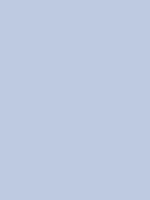#becae1 Color Information
In a RGB color space, hex #becae1 is composed of 74.5% red, 79.2% green and 88.2% blue. Whereas in a CMYK color space, it is composed of 15.6% cyan, 10.2% magenta, 0% yellow and 11.8% black. It has a hue angle of 219.4 degrees, a saturation of 36.8% and a lightness of 81.4%. #becae1 color hex could be obtained by blending #ffffff with #7d95c3. Closest websafe color is: #cccccc.
-
- R 75
- G 79
- B 88
-
- C 16
- M 10
- Y 0
- K 12
● #becae1 color description : Light grayish blue.
#becae1 Color Conversion
The hexadecimal color #becae1 has RGB values of R:190, G:202, B:225 and CMYK values of C:0.16, M:0.1, Y:0, K:0.12. Its decimal value is 12503777.
| Hex triplet | becae1 | #becae1 |
|---|---|---|
| RGB Decimal | 190, 202, 225 | rgb(190,202,225) |
| RGB Percent | 74.5, 79.2, 88.2 | rgb(74.5%,79.2%,88.2%) |
| CMYK | 16, 10, 0, 12 | |
| HSL | 219.4°, 36.8, 81.4 | hsl(219.4,36.8%,81.4%) |
| HSV (or HSB) | 219.4°, 15.6, 88.2 | |
| Web Safe | cccccc | #cccccc |
| CIE-LAB | 81.084, 0.559, -12.781 |
|---|---|
| XYZ | 55.944, 58.624, 79.598 |
| xyY | 0.288, 0.302, 58.624 |
| CIE-LCH | 81.084, 12.793, 272.503 |
| CIE-LUV | 81.084, -7.639, -19.982 |
| Hunter-Lab | 76.566, -3.568, -8.042 |
| Binary | 10111110, 11001010, 11100001 |
Color Schemes with #becae1
Alternatives to #becae1
Below, you can see some colors close to #becae1. Having a set of related colors can be useful if you need an inspirational alternative to your original color choice.
#becae1 Preview
This text has a font color of #becae1.
<span style="color:#becae1;">Text here</span>This paragraph has a background color of #becae1.
<p style="background-color:#becae1;">Content here</p>This element has a border color of #becae1.
<div style="border:1px solid #becae1;">Content here</div>.text {color:#becae1;}.background {background-color:#becae1;}.border {border:1px solid #becae1;}Shades and Tints of #becae1
A shade is achieved by adding black to any pure hue, while a tint is created by mixing white to any pure color. In this example, #010102 is the darkest color, while #f4f6fa is the lightest one.
-
#010102
#010102rgb(1,1,2) -
#070a10
#070a10rgb(7,10,16) -
#0d131d
#0d131drgb(13,19,29) -
#141b2a
#141b2argb(20,27,42) -
#1a2438
#1a2438rgb(26,36,56) -
#202d45
#202d45rgb(32,45,69) -
#263553
#263553rgb(38,53,83) -
#2c3e60
#2c3e60rgb(44,62,96) -
#33476d
#33476drgb(51,71,109) -
#394f7b
#394f7brgb(57,79,123) -
#3f5888
#3f5888rgb(63,88,136) -
#456196
#456196rgb(69,97,150) -
#4b69a3
#4b69a3rgb(75,105,163)
-
#5372af
#5372afrgb(83,114,175) -
#607db6
#607db6rgb(96,125,182) -
#6d88bc
#6d88bcrgb(109,136,188) -
#7b93c2
#7b93c2rgb(123,147,194) -
#889ec8
#889ec8rgb(136,158,200) -
#96a9ce
#96a9cergb(150,169,206) -
#a3b4d5
#a3b4d5rgb(163,180,213) -
#b1bfdb
#b1bfdbrgb(177,191,219) -
#becae1
#becae1rgb(190,202,225) -
#cbd5e7
#cbd5e7rgb(203,213,231) -
#d9e0ed
#d9e0edrgb(217,224,237) -
#e6ebf4
#e6ebf4rgb(230,235,244) -
#f4f6fa
#f4f6fargb(244,246,250)
Tones of #becae1
A tone is produced by adding gray to any pure hue. In this case, #cdcfd2 is the less saturated color, while #a1c1fe is the most saturated one.
-
#cdcfd2
#cdcfd2rgb(205,207,210) -
#c9cdd6
#c9cdd6rgb(201,205,214) -
#c5ccda
#c5ccdargb(197,204,218) -
#c2cbdd
#c2cbddrgb(194,203,221) -
#becae1
#becae1rgb(190,202,225) -
#bac9e5
#bac9e5rgb(186,201,229) -
#b7c8e8
#b7c8e8rgb(183,200,232) -
#b3c7ec
#b3c7ecrgb(179,199,236) -
#afc5f0
#afc5f0rgb(175,197,240) -
#acc4f3
#acc4f3rgb(172,196,243) -
#a8c3f7
#a8c3f7rgb(168,195,247) -
#a4c2fb
#a4c2fbrgb(164,194,251) -
#a1c1fe
#a1c1fergb(161,193,254)
Color Blindness Simulator
Below, you can see how #becae1 is perceived by people affected by a color vision deficiency. This can be useful if you need to ensure your color combinations are accessible to color-blind users.
